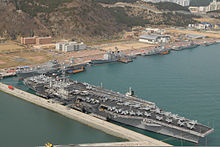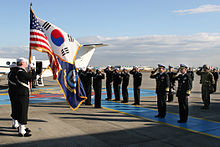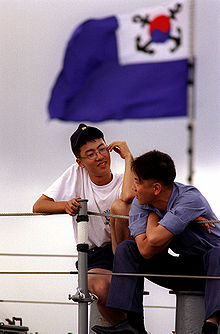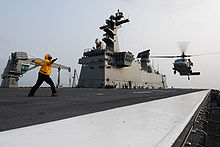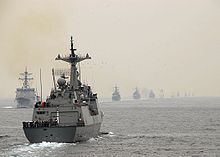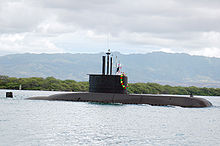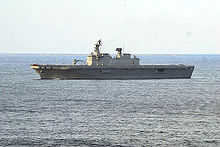- Republic of Korea Navy
-
Republic of Korea Navy
대한민국 해군 (Daehanminguk Haegun)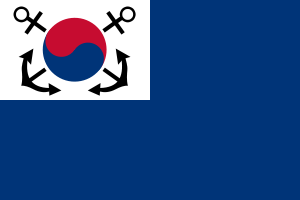
Jack of the Republic of Korea NavyActive November 11, 1945 - present Country  Republic of Korea
Republic of KoreaType Navy Size 68,000 personnel
170 ships, 70 aircraft[1]Part of Ministry of National Defense (Republic of Korea) Garrison/HQ Gyeryong Motto To the sea, to the world
(바다로, 세계로)March Haegunga - Navy anthem (해군가) Mascot Haedori (해돌이) Anniversaries November 11 (Navy Foundation Day) Engagements Korean War
Vietnam War
War on TerrorismCommanders Chief of Naval Operations (CNO) Admiral Choi Yoon-hee (29th) Commander-in-Chief ROK Fleet Vice Admiral Koo Ok-hyoe (22nd) Commandant of the ROK Marine Corps Lieutenant General Lee Ho-yeon (30th) Notable
commandersVice Admiral Sohn Won-yil (1st CNO)[2] Insignia Official logo 
Aircraft flown Helicopter Lynx, UH-60, UH-1 Patrol P-3 Command structureParent unit ROK Navy HeadquartersComponents Republic of Korea Fleet
Republic of Korea Marine Corps
Naval Logistics Command
Naval Education and Training Command
Naval AcademyThe Republic of Korea Navy (Hangul: 대한민국 해군; Hanja: 大韓民國 海軍; Revised Romanization: Daehanminguk Haegun) or the ROK Navy (ROKN) is the branch of the South Korean armed forces responsible for conducting naval operations and amphibious landing operations.[3] The ROK Navy includes the Republic of Korea Marine Corps, which is a quasi-autonomous organization.[4] The oldest service in the ROK Armed Forces, the South Korean navy celebrated its 60th anniversary in 2005.
Since the Korean War, the ROK Navy concentrated its efforts to build naval forces to counteract the North Korean navy, which has littoral naval capabilities. As South Korea's economy grew, the ROK Navy was able to build larger and better equipped fleets to deter aggression, to protect national maritime rights and to support the nation's foreign policies.[5] As a part of its mission, the ROK Navy has engaged in several peacekeeping operations since the turn of the century.[6]
The ROK Navy has about 68,000 regular personnel including 27,000 Republic of Korea Marines (as of 2010). There are about 170 commissioned ships (with a total displacement of about 181,000 tons[7] ) in the ROK Navy, including some 20 destroyers and frigates, 12 submarines, 100 corvettes and fast attack craft as of 2011. The naval aviation force consists of about 70 fixed-wing and rotary-wing aircraft. The ROK Marine Corps has about 400 tracked vehicles including self-propelled artillery.[1]
The ROK Navy aims to become an ocean-going navy by 2020.[8]
Duties and objectives
The main duties of the Navy shall be operations on the sea and landing operations, and the Navy shall be formed and equipped for that purpose and shall provide education and training necessary therefor.—Act on the Organization of National Armed Forces[9]The objectives of the ROK Navy as maritime forces for the National Security are:
- Establishing autonomous naval forces to deter war
- Securing maritime superiotiy to win war
- Promoting national interests through protection of maritime activities
- Enhancing the national prestige through naval presence[10]
History
Main article: History of the Republic of Korea NavyOrigins
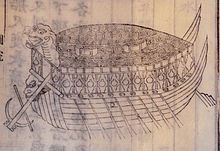 16th century Korean turtle ship in a depiction dating to 1795 based on a contemporary, late 18th century model. Located at War Memorial of Korea, Seoul.[11]
16th century Korean turtle ship in a depiction dating to 1795 based on a contemporary, late 18th century model. Located at War Memorial of Korea, Seoul.[11]
Korea has a long history of naval activity. In the late 4th century during the Three Kingdoms Period, Goguryeo defeated Baekjae, fielding amphibious forces of 40,000 men in the process. In the 9th century, Commissioner Chang Bogo of Unified Silla established a maritime base called Cheonghaejin on an island to foster trading with China and Japan, and to cope with pirates.
In 1380, naval forces of the Goryeo Dynasty defeated 500 invading Japanese pirate vessels by deploying shipboard guns, devised by Choi Moosun. This is reportedly the first use of shipboard guns in naval history. In 1389 and 1419, Korean naval forces invaded Tsushima Island to suppress Japanese piracy. In the early years of the Joseon Dynasty, the naval force reached its peak of 50,000 personnel, in order to combat the ongoing piracy issue.[12]
During the Japanese invasions of Korea (1592–1598), the Korean naval force commanded by Admiral Yi Sunshin, who later became the head of the Navy, cut off the invaders' naval lifeline and defeated the Japanese fleet, reversing the war in favor of Joseon.[13] Admiral Yi is also credited with the creation of the Turtle Ship.
By the end of 19th century, the Joseon Navy had no significant naval force[14] other than coastal defense fortresses. Although there was an attempt to modernize the navy by establishing a royal naval school, the Joseon Navy was brought to an end in 1895. In 1903, the government of the Korean Empire purchased its first modern war ship, the Yangmu.[15] Korean naval tradition was disrupted after Korea was annexed by the Empire of Japan in 1910. During the Japanese occupation period, the Imperial Japanese Navy built a naval base - Chinkai Guard District in southern Korea (at present-day Jinhae).
Founding years and Korean War
Shortly after Korea was liberated from the Empire of Japan on August 15, 1945, a former merchant mariner and son of the independence activist Sohn Jung-do,[16] Sohn Won-yil led the Maritime Affairs Association, which evolved into the Marine Defense Group on November 11, 1945 (later became Navy Foundation Day) and later became the Korean Coast Guard, which was formed in Jinhae. After the new Republic of Korea government was established on August 15, 1948, the Korean Coast Guard was formally renamed the Republic of Korea Navy, and Sohn became the first Chief of Naval Operations of the ROK Navy on September 5, 1948.[17] On April 15, 1949, the Republic of Korea Marine Corps (ROKMC) was founded in Jinhae. In October 1949, the ROK Navy purchased a 600-ton submarine chaser, the former Korean War started with the North Korean army's surprise attack on Sunday, June 25, 1950. The ROK Navy confronted threats from the North Korean navy: "Perhaps the most aggressive and effective, if smallest, member of the South Korean armed services during the first year of the Korean War was the Republic of Korea Navy (ROKN). At the outset of the conflict, the 6,956-man ROKN, with [33][20] naval vessels of various types, was outnumbered by the 13,700 men and 110 naval vessels of the North Korean navy."[21] With its UN allies, dominated by U.S. forces, the ROK Navy was able to gain control in the seas surrounding the country. On July 27, 1953, the three year-long war was brought to an end when an armistice agreement was signed. During the war, Australia, Canada, Colombia, France, the Netherlands, New Zealand, Thailand, the United Kingdom, and the United States contributed naval vessels as UN allies; Denmark sent the hospital ship Jutlandia.[22]
Commander-in-Chief Republic of Korea Fleet, the highest operational command, was established in September 1953.
 The home-built Ulsan class frigate, ROKS Gyeongbuk (FF 956)
The home-built Ulsan class frigate, ROKS Gyeongbuk (FF 956)
Starting in the 1950s, the ROK Navy built up its surface fleet mainly with older warships transferred from the United States Navy. In May 1963, the ROK Navy acquired its first destroyer ROKS Chungmu (DD 91 and later DD 911), the former USS Erben (DD-631), a Fletcher class destroyer. Starting from 1972, nine former USN Allen M. Sumner class and Gearing class destroyers were transferred and added to the ROK Fleet inventory.
During the Vietnam War, the ROK Navy dispatched a naval transport squadron called Baekgu, which was composed of 3 LSTs and 2 LSMs. The Republic of Korea Marine Corps sent into a combat brigade called Cheongnyong to Vietnam.
On January 19, 1967, ROKS Dangpo (PCEC 56), the former USS Marfa (PCE-842), was sunk by North Korean coastal artillery north of the demarcation line off the east coast of Korea[23] In June 1970, a navy broadcast vessel (ROKS I-2) was captured by North Korean patrol craft in the vicinity of Yeonpyeong Islands in the West Sea (Yellow Sea).[24]
In the 70s, the ROK Navy, through the Park Chung-hee Administration's "Yulgok Plan" (an eight-year national defense plan "to build up self-reliant, national defense capability"[25]), began to build naval forces with indigenous technology; this initiated the ROK Navy effort to build a fleet of locally built ships. The first 2,000-ton frigate ROKS Ulsan (FF 951) was launched in 1980 and the first 1,000-ton corvette ROKS Pohang (PCC 756) was launched in 1982, both featuring indigenous technology. The ROK Navy continued to carry out other new shipbuilding projects such as mine sweepers, logistic support ships and amphibious landing ships in the 80s and 90s.
In 1973, the Republic of Korea Marine Corps, once a separate branch of the armed forces, became a part of the Navy.
ROKS Gwanggaeto the Great (DDH 971), the ROK Navy's first home-built destroyer
Since the 90s, the ROK Navy has been steadily upgrading its naval forces. In 1995, Admiral An Pyongtae, the Chief of Naval Operations, presented his plan for the future of the ROK Navy, which included building a blue-water navy.[26]
As a part of a plan to strengthen the surface combatant forces, the ROK Navy launched the lead ship of the Gwanggaeto the Great class destroyer in 1996 to replace the former U.S. Navy destroyers. For building up a submarine force, the ROK Navy purchased its first submarine (other than midget submarines), the Chang Bogo (SS 061), from Howaldtswerke-Deutsche Werft of Germany in 1992. In order to replace its antiquated S-2 Tracker anti-submarine warfare airplanes, South Korea purchased a squadron of P-3C Orion maritime patrol aircraft. These were delivered to the ROK Navy starting in 1995.
The ROK Navy continues to put its efforts to build a blue-water navy. In 2001, then-President Kim Dae-jung announced a plan for building up the Strategic Mobile Fleet.[27]
In 2002, the lead ship (ROKS Chungmugong Yi Sunshin (DDH-975)) of the 5,500-ton Chungmugong Yi Sunshin class destroyer was launched.[28] In 2005, the 18,800-ton amphibious landing ship, ROKS Dokdo (LPH 6111) was launched. In 2006, the ROK Navy launched the lead ship (SS 072) of the 1,800-ton Sohn Wonyil class submarine, which was named after the first Chief of Naval Operations, equipped with an Air-Independent Propulsion (AIP) system. In May 2007, the ROK Navy launched the lead ship (DDG 991) of the 11,000-ton Sejong the Great class destroyer, built around the American-made AEGIS combat system and the SPY-1D(v) multi-function phased array radar.
As a part of its mission, the ROK Navy participated in several peacekeeping operations since the turn of the century.[6]
On March 26, 2010, ROKS Cheonan, a Pohang class corvette was sunk by a North Korean torpedo, resulting in death of 46 sailors near Baengnyeong Island, in the vicinity of the Northern Limit Line (NLL).[29][30]
Command and organization
For more details on this topic, see List of operating units and shore establishments of the Republic of Korea Navy.The Republic of Korea Navy includes the Republic of Korea Navy Headquarters, Republic of Korea Fleet, Republic of Korea Marine Corps, Naval Education and Training Command, Naval Logistics Command, and Naval Academy. The Chief of Naval Operations (CNO) is the highest-ranking officer of the ROK Navy.
Senior leadership
As of November 2011, the following people were in office:
- Chief of Naval Operations: Admiral Choi Yoon-hee (based in Republic of Korea Navy Headquarters, Gyeryong)
- Commander-in-Chief Republic of Korea Fleet: Vice Admiral Koo Ok-hyoe (based in Republic of Korea Fleet command headquarters, Busan)
- Commandant of the Republic of Korea Marine Corps: Lieutenant General Lee Ho-yeon (based in Headquarters Republic of Korea Marine Corps, Hwaseong)
- Commander Naval Education and Training Command: Vice Admiral Jung Ho-sub (based in Jinhae)
- Commander Naval Logistics Command: Rear Admiral (Upper Half) Im Jong-cheol (based in Jinhae)
- Superintendent Republic of Korea Naval Academy: Vice Admiral Sohn Jeong-mok (based in Jinhae)
Organization
The ROK Navy is led by the Chief of Naval Operations (CNO). The Republic of Korea Navy Headquarters located within the Gyeryongdae complex, the tri-service headquarters in Gyeryong, includes the office of the Chief of Naval Operations and various agencies and staff functions. The CNO is a four-star admiral and a member of the Joint Chiefs of Staff. The CNO oversees the administration of recruiting, organizing, training, equipping, supplying, and mobilizing the ROK Navy.[31]
Republic of Korea Fleet
Commander-in-Chief Republic of Korea Fleet (CINCROKFLT) is responsible for naval operations, and based at Busan Naval Operations Base with a command headquarters. CINCROKFLT also serves as Commander Naval Component Command (CNCC) of the ROK-US Combined Forces Command (CFC) in peacetime, or as the Deputy Commander Combined Naval Component Command (DCCNCC) in wartime. The Republic of Korea Fleet has three numbered fleets each assigned to the seas east, west, and south of South Korea:
-
-
- Commander First Fleet (base: Donghae)
- Commander Second Fleet (base: Pyeongtaek)
-
- Incheon Naval Sector Defense Command
- Commander Third Fleet (base: Mokpo)
-
- Jeju Defense Command
-
For various types of naval operations, the ROK Navy has two surface flotillas, a naval aviation force, a submarine flotilla, special warfare (UDT/SEAL) forces, and a training squadron under the command of the CINCROKFLT:
-
-
- Component Flotilla Five
-
- Mine Warfare Squadron 52
- Amphibious Squadron 53
- Rescue and service squadron 55
-
- Ship Salvage Unit
- Air Wing Six
- Maritime Task Flotilla Seven
-
- Maritime Task Squadron 71
- Maritime Task Squadron 72
- Submarine Flotilla Nine
- Naval Special Warfare Brigade
- Maritime Tactical Intelligence Group
- Training squadron
- Busan naval base squadron
-
As a part of "Defense Reform 2020," which was proposed by the Roh Moo-hyun Administration, the ROK Navy has been directed to reform its submarine operations command into a fleet submarine force.[32][33]
Gidong Budae
When taking command of the Navy in 1995, Admiral An Pyongtae, then Chief of Naval Operations, proposed to build a blue-water navy for the Republic of Korea. In the year 2001, President Kim Dae-jung announced a plan for creating a task force called "strategic maneuver fleet" (전략기동함대; Jeollyak Gidong Hamdae), which will "protect national interests in the five oceans and contribute to world peace" .[27] As part of the plan, the ROK Navy established one task group, Commander Maritime Task Flotilla Seven on February 1, 2010, which evolved from Commander ASW Squadron 51 of the Component Flotilla. The Maritime Task Flotilla is composed of two Sejong the Great class AEGIS guided missile destroyers, and six Chungmugong Yi Sunshin class destroyers.[34]
Republic of Korea Marine Corps
Main article: Republic of Korea Marine CorpsThe Naval Education and Training Command is one of the two major shore commands of the ROK Navy responsible for training. It is located in Jinhae. Its primary role is to conduct the initial orientation and basic training for new recruits of the Navy and the Korea Coast Guard. One of the major subordinate units is the Naval War College located in Daejeon.
The Naval Logistics Command is the other major shore command of the ROK Navy. It also operates the Naval Ship Yard located in Jinhae.
The Republic of Korea Naval Academy is a four-year coeducational service academy located in Jinhae. It was established in 1946. Graduates are commissioned as Ensigns in the Navy or Second Lieutenants in the Marine Corps. The Naval Academy also hosts the Officer Candidate School, which provides training to become commissioned officers for civilian college graduates and candidates with military experience.
Location
The ROK Navy operates several naval bases in South Korea: Jinhae, Busan, Donghae, Pyeongtaek, Mokpo, Incheon, Pohang. Naval air stations are in Pohang, Jinhae, and Mokpo. Jinhae has been the major port for the ROK Navy since the establishment of the Korean Coast Guard by hosting vital naval facilities including the Naval Shipyard. Busan has become another major naval base for the CINCROKFLT since its Command Headquarters moved from Jinhae in 2007. Donghae, Pyeongtaek, and Mokpo each hosts a Fleet Command under a Rear Admiral (Upper Half). Incheon hosts a Defense Command under an one-star admiral responsible for littoral waters close to Seoul, the nation's capital. Pohang has a naval base for amphibious forces such as the 1st Marine Division located nearby. The ROK Navy also plans to build a new naval base on the southern coast of Jeju-do for basing a squadron of the Maritime Task Flotilla and two submarine squadrons by 2014. The ROK Navy plans to strengthen its control over the seas around the Korean Peninsula by deploying these forces.
South Korea has a joint military partnership with the United States as outlined by the Mutual Defense Treaty signed on 1951. Commander U.S. Seventh Fleet (C7F) is designated as Commander Combined Naval Component Command (CCNCC) "for the defense of the Korean peninsula; in the event of hostilities, all friendly naval forces in the theater would fall under C7F control."[35] The ROK and US Governments have agreed on the transfer of wartime operational control to the South Korean government in 2015.
Commander Naval Forces Korea (CNFK) is a shore command of the United States Navy that serves as the shore support agency for all U.S. Naval activity in South Korea. Commander Fleet Activities Chinhae (CFAC) is a U.S. Naval installation in Jinhae.
Personnel
The ROK Navy has about 68,000 personnel, including the 27,000 members of the ROK Marine Corps (as of 2010). Among these members, about 11 percent of them are commissioned officers and about 32 percent of them are non-commissioned officers (including warrant officers).[36] As a part of "Defense Reform 2020," which was proposed by the Roh Moo-hyun Administration, the ROK Navy has been directed to reduce its manpower to 64,000 sailors, airmen, and Marines.[33]
Military service is mandatory for all South Korean men. In the ROK Navy, all members are volunteers, with enlisted sailors and airmen serving for 26-month periods, and enlisted Marines serving for 24-month periods; commissioned officer, warrant officer, and non-commissioned officer serving longer terms than those of enlisted men, or as career sailor, airmen, and Marines. In the year 2001, six female ensigns, who had become commissioned officers through the officer candidate school, were assigned to serve on surface ships of the ROK Navy, for the first time ever.[37]
Commissioned officers
 A Korean naval cadet - midshipwoman, waves to fellow sailors aboard ROKS Daecheong (AOE 58).
A Korean naval cadet - midshipwoman, waves to fellow sailors aboard ROKS Daecheong (AOE 58).
There are several paths to becoming a commissioned officer in the ROK Navy, including the Naval Academy, Officer Candidate School (OCS), and Naval Reserve Officer Training Corps (NROTC). Officer Candidate School, located at the Naval Academy, Jinhae, provides training for candidates with current or prior enlisted experience in the military and civilian college graduates, which take majority in OCS.
Warrant officers
Following the traditions of the British Royal Navy the warrant officer rank in the South Korean armed forces falls in between that of non-commissioned and commissioned officers. In the ROK Navy, warrant officers are mostly former non-commissioned officers who had earned the rating of Wonsa (Master Chief Petty Officer) and who had been selected for and completed a warrant officer candidate program. Another route to becoming a naval warrant officer is to complete a naval aviation warrant officer candidate program. Warrant officers generally mess in the wardroom with commissioned officers.
Petty officers
Petty officers originate from a petty officer candidate program. In the ROK Navy, personnel with ranks of Hasa through Wonsa are considered petty officers (i.e. non-commissioned officers) while those at Sangsa and Wonsa are further referred to as “CPO” (chief petty officer) collectively. There are the appointments of Juim Wonsa and Juim Sangsa equivalent to that of the U.S. Navy's Command Master Chief Petty Officer (CMCPO). The positions are filled by senior Wonsa and Sangsa respectively and unlike their U.S. Navy counterparts, the ROK Navy Juim Wonsa and Juim Sangsa wear the same standard rate insignia of Wonsa or Sangsa and only wear a special identification badge. Every ROK Navy establishment and ship has either Juim Wonsa or Juim Sangsa. Petty officers wear a combination cap with a white cover and a gold chinstrap.
Enlisted
In the ROK Navy, enlisted sailors are referred to as "Subyeong" (수병; 水兵). Normally the enlisted sailors serve in the Navy for 26 months; after this, most of them are transferred from active duty to the naval reserve.
Ranks and rates
See also: Comparative military ranks of KoreaIn the ROK Navy, as in the rest of the ROK Armed Forces, ranks fall into one of four categories: commissioned officer, warrant officer, non-commissioned officer (petty officer), and enlisted, in decreasing order of authority. Commissioned officer ranks are subdivided into "Janggwan"-level officers (flag officers), "Yeonggawan"-level officers (Lieutenant Commander through Captain), and "Wigwan"-level officers (Ensign through Lieutenant). All three branches - the Army, the Navy, and the Air Force) of the ROK Armed Forces share the same names of ranks as written in Hangul.
ROK Armed Forces rank Translation U.S. Navy equivalent Insignia Commissioned Officers (장교; 將校; Janggyo) 장관 (將官; Janggwan) 원수 (元帥; Wonsu)¹ Fleet Admiral 대장 (大將; Daejang) Admiral 중장 (中將; Jungjang) Vice Admiral 소장 (少將; Sojang) Rear Admiral (Upper Half) 준장 (准將; Junjang) Rear Admiral (Lower Half) 영관 (領官; Yeonggwan) 대령 (大領; Daeryeong) Captain² 중령 (中領; Jungnyeong) Commander 소령 (少領; Soryeong) Lieutenant Commander 위관 (尉官; Wigwan) 대위 (大尉; Daewi) Lieutenant 중위 (中尉; Jungwi) Lieutenant Junior Grade 소위 (少尉; Sowi) Ensign Warrant Officers (준사관; 准士官; Junsagwan) 준위 (准尉; Junwi) Warrant Officer Chief Warrant Officer Petty Officers (부사관; 副士官; Busagwan) 원사 (元士; Wonsa) Master Chief Petty Officer Master Chief Petty Officer, Senior Chief Petty Officer 상사 (上士; Sangsa) Chief Petty Officer Chief Petty Officer 중사 (中士; Jungsa) Senior Petty Officer Petty Officer First Class 하사 (下士; Hasa) Petty Officer Petty Officer Second Class Enlisted (병; 兵; Byeong) 병장 (兵長; Byeongjang) Leading Seaman Petty Officer Third Class 
상등병 (上等兵; Sangdeungbyeong) Able Seaman seamen 
일등병 (一等兵; Ildeungbyeong) Seaman First Class Seaman Apprentice 
이등병 (二等兵; Ideungbyeong) Seaman Second Class Seaman Recruit 
¹: No one held the rank of Wonsu in the history of the ROK Armed Forces yet.
²: Senior Captains in command of Squadrons can be referred to as “Commodore” verbally and in correspondence as in the U.S. Navy.- Battle of Haeju
- Gangneung Infiltration
- Battle of Yosu
- First Battle of Yeonpyeong
- Second Battle of Yeonpyeong
- Battle of Daecheong
Major international activities
The ROK Navy frequently participates in multinational exercises and international activities. Also it has engaged in several peacekeeping operations since the turn of the century.
- Pacific Reach: The ROK Navy has participated in the biannual submarine rescue exercise since 2000. In 2004, the ROK Navy hosted the exercise, which was the first multinational naval exercise the ROK Navy ever hosted.
- RIMPAC: The ROK Naval forces have participated in the biannual multilateral naval exercise since 1990.
- ROK-US combined amphibious landing exercise: The ROK Navy and ROKMC together with the U.S. Navy and U.S. Marine Corps conduct the exercise annually in Korea.
- ROKN-JMSDF SAREX: The ROK Navy and Japan Maritime Self Defense Force (JMSDF) conducted the search and rescue exercise biannually since 1999.
- WP MCMEX/DIVEX: The mine warfare forces of the ROK Navy have participated in the Western Pacific Mine Counter Measure Exercise/Diving Exercise since 2004.
- Cruise Training: Since 1954, the ROK Navy has conducted the annual oceangoing training with the fourth year midshipmen (naval cadets) of the Naval Academy to provide on the job training before commissioning them and to foster relations with other navies around the world.
- Navy to Navy Talks: The ROK Navy holds regular naval conferences with its counterparts of Germany, Indonesia, Japan, Malaysia, Singapore, Thailand, Turkey, the United Kingdom, and United States.[38]
- Cobra Gold: Together with the ROK Marines, ROKS Seonginbong (LST 685) had participated in Cobra Gold 2010.
Anti-piracy operations
Further information: Piracy in SomaliaIn March 2009, the ROK Navy deployed the Cheonghae task group in response to piracy attacks in shipping lanes off the coast of Somalia. This task group is composed of a Chungmugong Yi Sunshin class destroyer and about 30 naval special warfare personnel. The group operates as part of the multinational task force, Combined Task Force 151 of Combined Maritime Forces (CMF).[39] The ROK Navy has dispatched five warships to the mission area under the name of Cheonghae task group. As of September 2010, ROKS Wang Geon (DDH 978) is carrying out the mission in the area. On January 21, 2011 South Korean naval commandos carried out Operation Dawn of Gulf of Aden, an operation to rescue the crew of the hijacked MV Samho Jewelry and succeed in rescuing the crew and killing or capturing all of the pirates on board.[40]
International fleet review
In October 1998, the ROK Navy hosted its first international fleet review in commemoration of the 50th anniversary of the Republic of Korea and its armed forces off coast of Busan and Jinhae. 21 ships from 11 countries (Australia, Bangladesh, France, India, Indonesia, Japan, New Zealand, Philippines, Singapore, United Kingdom, United States) participated in the fleet review as well as 34 ships and 15 aircraft from South Korea.[41][42] The ROK Navy hosted its second international fleet review off coast of Busan in October 2008 to celebrate the 60th anniversary of the South Korean government. 22 ships from 11 countries (Australia, Canada, China, India, Indonesia, Japan, Russia, Singapore, Thailand, United Kingdom, United States) participated in the fleet review as well as 33 ships and 27 aircraft from South Korea.[43][44]
The Cruise Training Unit - ROKS Kwaggaeto the Great (DDH 971), ROKS Jeju (FF 958) and ROKS Cheonji (AOE 57) participated in International Fleet Review 2002 commemorating the 50th anniversary of JMSDF in Tokyo Bay. The Cruise Training Fleet - ROKS Chungmugong Yi Sunshin (DDH 975) and ROKS Cheonji (AOE 57) - visited the United Kingdom in order to take part in the International Fleet Review for Trafalgar 200 in 2005. In April 2009, ROKS Dokdo (LPH 6111) and ROKS Kang Gamchan (DDH 979) attended an international fleet review to celebrate the 60th anniversary of the founding of the Chinese People's Liberation Army (PLA) Navy in Qingdao. In August 2009, the Cruise Training Flotilla - ROKS Choi Young (DDH 981) and ROKS Daecheong (AOE 58) participated in the Indonesian International Fleet Review, which commemorates the 64th anniversary of Indonesian independence.
Equipment
There are about 170 commissioned ships (with a total displacement of about 181,000 tons)[45] in the ROK Navy, including some 20 destroyers and frigates, 12 submarines, 100 corvettes and fast attack craft as of 2011. The naval aviation force consists of about 70 fixed-wing and rotary-wing aircraft.
Ships
For more details on this topic, see List of Republic of Korea Navy ships.The ROK Navy employs the U.S. Navy-style letter based hull classification symbols to designate the types of its ships and hull numbers to uniquely identify its vessels (e.g. DDH 975). The names are that of the historical figures, provinces, cities, counties, peaks, lakes, islands, and birds. The Chief of Naval Operations selects the names of ships.[46]
There are four ship ratings. A first-rate ship (DDH, LPH, MLS, AOE, and ARS) is commanded by a captain; a second-rate ship (FF, SS, LST, and ATS) by a commander; a third-rate ship (PCC, SSM, PKG, MSH, and MHC) by a lieutenant commander; and a fourth-rate (PKM and LSF) is commanded by a lieutenant.
Major commissioned ships
The ship prefix for all the commissioned ROK Navy ship is ROKS (Republic of Korea Ship) when the names of ships are written in English.
Surface combatants (destroyers and frigates)
- Sejong the Great class (DDG: Destroyer Guided-missile; 2 in service)
- Chungmugong Yi Sunshin class (DDH: Destroyer Helicopter; 6 in service)
- Gwanggaeto the Great class (DDH; 3 in service)
- Ulsan class (FF: Frigate; 9 in service)
Submarines
- Sohn Wonyil class (SS: Submarine; 3 in service)
- Chang Bogo class (SS; 9 in service)
- edit] Patrol ships (corvettes and patrol craft)
- Pohang class (PCC: Patrol Combat Corvette; 21 in service)
- Donghae class (PCC; all decommissioned)
- Yoon Youngha class (PKG: Patrol Killer Guided-missile; 4 in service)[47]
- Chamsuri class (PKM: Patrol Killer Medium; approx. 70 in service)
Amphibious warfare ships
- Dokdo class (LPH: Landing Transport Helicopter;[48] 1 in service)
- Gojunbong class (LST: Landing Ship Tank; 4 in service)
- Solgae 621 class (LSF: Landing Ship Fast; (Project 12061E Murena-E); transferred from Russia; 3 in service)[49][50][51]
- edit] Mine warfare ships
- Wonsan class (MLS: Minelayer Ship; 1 in service)
- edit] Auxiliary ships
- Edenton class; 2 in service)
- edit] Ships under construction
- Sejong the Great class (DDG; 3 in this class; 2 in service; 1 launched)
- Sohn Wonyil class (SS; 9 in this class: 3 in service; 3 under construction; 3 more planned)[55]
- Yoon Youngha class (PKG; 18 in this class: 4 in service; 4 launched; 2 under construction; 8 more planned)
- Incheon class (FFG; 18~24 in this class: 1 launched; 17~23 more planned)[56]
Aircraft
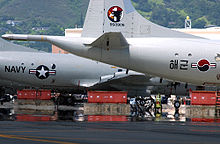 A P-3C Orion of the ROK Navy visiting the U.S. Marine Corps Air Station at Kaneohe, Hawaii in support of the RIMPAC 2004 exercise
A P-3C Orion of the ROK Navy visiting the U.S. Marine Corps Air Station at Kaneohe, Hawaii in support of the RIMPAC 2004 exercise
Commander Air Wing Six is the name of the ROK Navy that is responsible for all of its aircraft. This Air Wing's operational headquarters is located in Pohang, and its naval air stations are in Pohang, Jinhae, and Mokpo. Air Wing Six has about 20 fixed-wing and 50 rotary-wing aircraft as of 2011.
Aircraft Origin Type Versions In service Notes Bell Helicopter UH-1  United States
United Statesutility transport helicopter UH-1H 13 - Lockheed Martin P-3C Orion  United States
United StatesASW/surveillance aircraft P-3C
P-3CK8
8[57]-
P-3B modernized by KAIReims-Cessna F406 Caravan II  France
France
 United States
United Stateslight utility aircraft F406 5 - Sikorsky Aircraft UH-60  United States
United Statesutility transport helicopter UH-60P 7[58] built by KAL-ASD Westland Lynx  United Kingdom
United KingdomASW helicopter Lynx Mk.99
Super Lynx Mk.99A11
12[59]- Aérospatiale Alouette III  France
Francelight utility helicopter SA-319B 5[60] trainer Weaponry
Main article: List of Republic of Korea Navy weaponryOngoing projects
Ships
- Korean Submarine (KSS) program
Main article: Korean Attack Submarine programThe KSS program was a three-phased project to build up the ROK Navy's submarine forces. Before the KSS program, the submarine fleet of the ROK Navy consisted of midget submarines, such as the Dolgorae class submarine and SX 756 Dolphin class submarine, which had limited capabilities for inshore operations.
Through the first phase, KSS-I, the ROK Navy acquired nine 1,200-ton Chang Bo-go class submarines. For the second phase, KSS-II, the ROK Navy plans to acquire nine 1,800-ton Type 214 submarines with Air-Independent propulsion (AIP) system;[55] the lead ship of her class, the Sohn Won-yil (SS 072) was launched at a shipyard of Hyundai Heavy Industries on June 9, 2006. In June 2007, the ROK Navy launched its second 1,800-ton submarine named Jeong Ji, after a military general of the Goryeo Kingdom who defeated Japanese invaders. The Type 214 submarine is expected to play a key role in safeguarding the country's maritime interests as a part of the Navy's Mobile Flotilla. The third phase of the program, KSS-III is scheduled to begin in 2007 and to build the lead ship of her class in 2017. A total of nine 3,000-ton KSS-III submarines are expected to be built in South Korea with indigenous technologies (i.e. not going under license as the previous KSS-I and KSS-II submarines).[61]
- Korean Destroyer Experimental (KDX) program
Main article: Korean Destroyer eXperimentalKorean experimental destroyer program is a three-phased program to modernize the surface fleet by developing and constructing new destroyers for the ROK Navy with advanced combat systems and weaponry. The outcomes of this program include the Kwanggaeto the Great-class destroyers, which are the first ROK destroyers to be armed with surface-to-air missiles; the Chungmugong Yi Sunshin-class ASW destroyers; and the powerful King Sejong the Great-class destroyers, which are equipped with the sophisticated AEGIS combat system for air-defense and anti-missile operations. These new destroyers replaced antiquated destroyers that had been transferred from the U.S. Navy decades ago.
In October 2009, the ROK Navy announced plans to build and commission six destroyers of 5,600-ton empty displacement with the AEGIS system (the KDX-II A destroyers) from 2019 to 2026 for beefing up the Maritime Task Flotilla.[62]
- Frigate Experimental (FFX)
Main article: Future Frigate eXperimentalThe FFX project aims to replace the Ulsan class frigates and Donghae/Pohang class corvettes with new 2,300-ton frigates. The total number of the ships to built is 20 to 24 by 2020 and the first batch of six new frigates are planned to be commissioned by 2015, and another fourteen commissioned by 2018.[63] Hyundai Heavy Industries will build the lead ship that is planned to enter service in 2011.[64] These frigates will be armed with the American-made Phalanx CIWS system and the rolling airframe missile system, and they will each carry a Westland Lynx anti-submarine warfare helicopter.[65]
- Patrol Killer Experimental (PKX)
Main article: Patrol Killer eXperimentalThrough the PKX program, the ROK Navy plans to build a feet of a next generation patrol craft with Cooperative Engagement Capability and enhanced weaponry such as 76 mm guns and the KSSM anti-ship missiles. There are two variations of Geomdoksuri class patrol craft: Geomdoksuri-A and Geomdoksuri-B. The Geomdoksuri-A will be a 570-ton patrol craft with anti-ship missiles; Geomdoksuri-B will be a 300-ton patrol craft serving as the platform design for the Geomdoksuri-A variation. It is speculated that 34 Geomdoksuri-As[66] and 18 Geomdoksuri-Bs are planned. The first batch of nine Geomdoksuri-As are expected to enter in service by 2015 and to replace the aging Chamsuri class patrol craft.[67][68]
On 28 June 2007, the Yoon Young-ha (PKG 711), the lead ship of her class, was launched at the shipyard of Hanjin Heavy Industries in Busan. She is scheduled to be delivered to the South Korean navy in 2008.
- Landing Platform Experimental (LPX)
Main article: Dokdo class landing platform experimentalThe LPX project was the ROK Navy's new amphibious landing ship project for which Hanjin Heavy Industries & Constructions Co. has provided the general design package. The ROK Navy's requirements for the new amphibious landing ships were to enhance Korea's current amphibious operation capability, both in terms of assault and military operations other than war (MOOTW) type operations.
On 12 July 2005, ROKS Dokdo (LPH 6111), the lead ship of her class, was launched at the shipyard of Hanjin Heavy Industries in Busan. She was delivered to the South Korean navy in July, 2007. The first air cushion landing craft (ROKS LSF 631) of LSF-II project was delivered for ROKS Dokdo in April, 2007.
In October 2009, the ROKN revealed that it plans to commission a new 14,500-ton (full displacement 18,800 tons) LPX around 2018.[69]
- LST-II project
The ROK Navy plans to commission four new amphibious ships of 4,500-ton empty displacement between 2014 and 2017.
- AOE-II Project
The ROKN plans to commission an uncertain number of 12,000-ton fast combat support ships (AOE) around 2017 to relieve the 9,000-ton Cheonji class ships.
- ATS-II project
Through ATS-II project, the ROKN will replace the two ex-USN Beaufort class ships with two locally built 3500-ton salvage and rescue ships.
- Training Ship Experimental (ATX)
The ROK Navy plans to commission a new 4,500-ton training ship (ATX) for midshipmen and officer candidates around 2015.[70]
- MLS-II Project
The ROKN plans to build and commission an uncertain number of minelayer ships similar to ROKS Wonsan (MLS 560).
- MSH Phase 2
The ROKN plans to build and commission an uncertain number of mine countermeasure ships similar to the Yangyang class.
Aircraft
- Maritime patrol aircraft program phase II
The ROK Navy had acquired eight P-3C aircraft through the maritime patrol aircraft program phase I.[71] Eight more ex-USN P-3CK maritime patrol aircraft had been delivered to the ROK Navy by 2010 after undergoing extensive refubishment and modernization.
- Mine countermeasure helicopter program
The ROK Navy had planned to acquire new mine countermeasure helicopters by 2012 with a budget of 480 billion won. AgustaWestland EH-101, NHIndustries NH-90, and Sikorsky MH-60S were being considered as possible candidates for the acquisition program[72][73] before it decided to hold the project due to global financial crisis that hit the world in 2008.
See also
- Joseon Navy
- Naval history of Korea
- North Korean Navy
- Korea Coast Guard
- Yi Sunshin
Notes
- ^ a b "국방백서 2010". 2010-12-30. http://www.mnd.go.kr/cms_file/info/mndpaper/2010/2010WhitePaperAll.zip.
- ^ "[건군 60년] ④ 육·해·공군·해병대 名將". internethankookilbo. Retrieved October 12, 2008.
- ^ "Duty of the ROK Navy". Republic of Korea Navy Official Website. Retrieved March 10, 2007.
- ^ "해병대 조직". Republic of Korea Marine Corps Official Website. Retrieved March 26, 2007.
- ^ "해군의 역할". Republic of Korea Navy Official Website. Retrieved March 8, 2007.
- ^ a b "해군작전사령부 창설 54주년..어제와 오늘 그리고 미래". Ministry of National Defense Official Website. Retrieved March 4, 2007.
- ^ "Defense of Japan 2011". Ministry of Defense Official Website. Retrieved September 23, 2011.
- ^ "해군의 미래". Republic of Korea Navy Official Website. Retrieved September 24, 2011.
- ^ Act on the Organization of National Armed Forces. Republic of Korea National Assembly. 2010.
- ^ Republic of Korea Navy. Republic of Korea Navy. 2000.
- ^ Stephen Turnbull, “Samurai Invasion. Japan’s Korean War 1592-98” (London, 2002), Cassell & Co ISBN 0-304-35948-3, p. 243
- ^ "역사속의 해군". Republic of Korea Navy Official Website. Retrieved May 1, 2007.
- ^ "Korea’s Legendary Admiral (PDF Format)". barrystrauss.com. Retrieved May 1, 2007.
- ^ "The First US Naval Attaché to Korea". Central Intelligence Agency Official Website. Retrieved May 6, 2007.
- ^ "제3장 군사학교의 설립과 사관양성 (PDF Format)". Ministry of National Defense - Institution for Military History Compilation Official Website. Retrieved May 1, 2007.
- ^ "손원일 중장". War Memorial Museum Official Website. Retrieved May 2, 2007.
- ^ "Commander, U.S. Naval Forces Korea: The Early Years (1945 to 1957)". Commander U.S. Naval Forces Korea, U.S. Navy Official Website. Retrieved March 4, 2007.
- ^ "Pak Tu San (Submarine Chaser # PC-701, 1950-1960)" Department of the Navy – Naval Historical Center official website. Retrieved March 4, 2007.
- ^ "한국해군50년사". Republic of Korea Navy Official website. Retrieved March 4, 2007.
- ^ "6·25전쟁 발발 당일, 우리 해군의 함정 척수 및 병력". 해군 vol. 2003 9-10. Republic of Korea Navy. Retrieved October 21, 2007.
- ^ "Republic of Korea Navy". Department of the Navy – Naval Historical Center Official Website. Retrieved September 25, 2007.
- ^ "Allied Forces in the Korean War". Department of Defense – Korean War Commemoration Website. Retrieved September 25, 2007.
- ^ "Marta". Department of the Navy – Naval Historical Center Official Website. Retrieved April 30, 2007.
- ^ "남북간의 해상전과 남한 방송선 피랍사건". www.ceoi.org by O Wonchol. Retrieved October 4, 2007.
- ^ "ROK Army History". GlobalSecurity.org. Retrieved March 10, 2007.
- ^ "21세기 통일한국의 大洋해군 전략". Donga.com. Retrieved March 8, 2007.
- ^ a b "김대통령, 해군사관학교 졸업 및 임관식 참석말씀". Kim Dae-jung Presidential Library Official Website. Retrieved March 12, 2007.
- ^ "KDX-II Destroyer (ship list)". GlobalSecurity.org. http://www.globalsecurity.org/military/world/rok/kdx-2-unit.htm. Retrieved 6 February 2011.
- ^ Adam Brookes (2010-05-20). "'North Korean torpedo' sank South's navy ship - report". BBC News. http://news.bbc.co.uk/2/hi/world/asia_pacific/10129703.stm. Retrieved 2010-06-01.
- ^ "North Korea denies sinking warship; South Korea vows strong response". CNN.com. May 20, 2010. http://www.cnn.com/2010/US/05/19/south.korea.ship/index.html?hpt=T1. Retrieved 2010-06-01.
- ^ "Main Tasks of Each Troop". Republic of Korea Navy Official Website. Retrieved March 13, 2007.
- ^ "해군 1·2전투전단 21년만에 해체". kyunghyang.com. Retrieved March 7, 2007.
- ^ a b "2006 국방백서". Ministry of National Defense Official Website. Retrieved March 11, 2007.
- ^ "Navy Activates 1st strategic Mobile Fleet". Korea Times. Retrieved February 1, 2010.
- ^ "Forward Presence". Commander, U.S. Seventh Fleet Official Website. Retrieved October 21, 2007.
- ^ "성공적 국방개혁을 위한 인력구조 발전 방향". Korea Institute for Defense Analyses Official Website. Retrieved March 13, 2007.
- ^ "女해군장교들 첫 함정근무 (신문기사)". Ministry of Government Administration and Home affairs Official Website. Retrieved May 11, 2007.
- ^ "해군소개자료집 (PDF Format)". Republic of Korea Navy Official Website. Retrieved May 16, 2007.
- ^ "ROK Navy Task Group Chung-Hae Arrives in Bahrain". Commander, U.S. Naval Forces Central Command. Retrieved April 27, 2009.
- ^ "South Koreans pull off daring rescue of pirated ship". CNN. 21 January 2011. http://www.cnn.com/2011/WORLD/asiapcf/01/21/south.korea.pirate.rescue/index.html?hpt=T2. Retrieved 21 January 2011.
- ^ "{해군 국제관함식} 바다로, 세계로...". THE HANKOOKILBO. Retrieved March 10, 2007.
- ^ "'98 한국 관함식". Republic of Korea Navy official website. Retrieved October 13, 2008.
- ^ "11개국 함정 50여척 힘찬 퍼레이드". Republic of Korea Navy i-News. Retrieved October 13, 2008.
- ^ "부산 관함식 경제 효과 1088억원". Republic of Korea Navy i-News. Retrieved October 13, 2008.
- ^ "Defense of Japan 2011". Ministry of Defense Official Website. Retrieved September 23, 2011.
- ^ "함정 명명식". Republic of Korea Navy Official Website. Retrieved May 11, 2007.
- ^ "third Gumdoksuri class PKG spotted conducting combat exercise"
- ^ "독도함 시운전 보도에 대한 해군의 입장". Republic of Korea Navy Official Website. Retrieved March 4, 2007.
- ^ "러시아 공기부양정 1척 한국 도착". Republic of Korea Navy Official Website. Retrieved March 22, 2007.
- ^ "Navy Catalog" (PDF Format). Rosoboronexport State Export Corporation Official Website. Retrieved March 22, 2007.
- ^ "러시아제 공기부양정 동원". Joins.com. Retrieved April 5, 2007.
- ^ "해군, 차기 고속상륙정 '솔개' 전력화". YonhapNews. Retrieved April 2, 2007.
- ^ "최신예 국산 소해함 ‘해남함’ 취역". Republic of Korea Navy i-News. Retrieved March 10, 2007.
- ^ The Naval Institute Guide to Combat Fleets of the World, Eric Wertheim, Naval Institute Press, 2007 - ISBN 1-59114-955-X
- ^ a b "방사청, 英 구조잠수정 1척 도입키로". Republic of Korea Navy i-News. Retrieved March 11, 2007.
- ^ 차기호위함 1차 후속함사업자 현대중공업 선정
- ^ Defense Times Korea, vol. 93, March 2010
- ^ Leoni 2007, pp. 298-300.
- ^ "One dead, 3 missing in crash of Navy copter". Korea Herald. Retrieved May 4, 2010.
- ^ Defense Times Korea, vol. 84, June 2009
- ^ "3000t급 잠수함 개발 연내 착수". Joins.com. Retrieved March 7, 2007.
- ^ "S. Korean Navy to Build 6 Mini-Aegis Destroyers". Korea Times. Retrieved October 20, 2009.
- ^ "S. Korea May Deploy New Frigates Near Disputed Island". Retrieved Sep. 23, 2011.
- ^ "Hyundai Heavy Industries to Build New Frigate". The Korea Times. Retrieved February 6, 2009.
- ^ New S. Korean Frigate to Carry US Armament
- ^ "Ten more PKG vessels to be deployed to deter NK: source ". Retrieved Sep. 23, 2011.
- ^ "차기고속정 신형무기 내달 6일부터 시험평가 내년 10월쯤 실전 배치". SEGYE.com. Retrieved March 11, 2007.
- ^ "차기 고속정 ‘검독수리-A’ 전투체계 시연 완료". KBS News. Retrieved March 7, 2007.
- ^ "해군 2019년 5600톤급 차기구축함 확보". Korea Defense Daily. Retrieved October 20, 2009.
- ^ "해사 생도 지원 훈련함 2015년 전력화". Republic of Korea Navy i-News. Retrieved September 27, 2008.
- ^ "성능개량 예정 해상초계기 8대 도입". Republic of Korea Navy i-News. Retrieved March 23, 2007.
- ^ "S. Korean Navy to Buy 4 Mine Sweeper Choppers by 2012". Korea Times. Retrieved November 16, 2007.
- ^ "정부, 軍대형수송기 해외상업구매키로". YonhapNews. Retrieved November 16, 2007.
References
- Republic of Korea Navy official website
- Navy - South Korea GlobalSecurity.org
External links
- Republic of Korea Navy official website (Korean) (English)
- MaritimeQuest ROK Navy Index
- [War Memorial of Korea]
 Republic of Korea Armed Forces
Republic of Korea Armed Forces
Categories:
Wikimedia Foundation. 2010.





